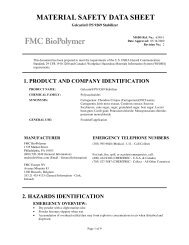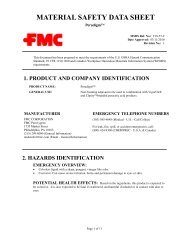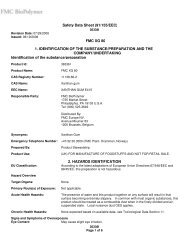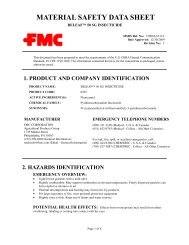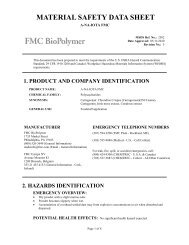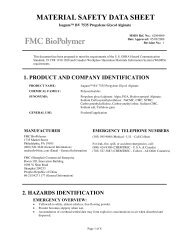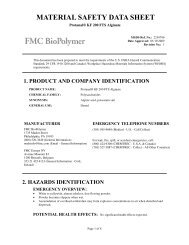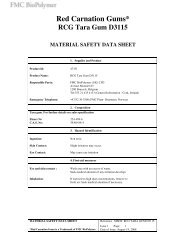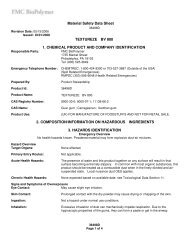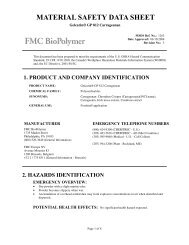Chairman's - FMC Corporation
Chairman's - FMC Corporation
Chairman's - FMC Corporation
You also want an ePaper? Increase the reach of your titles
YUMPU automatically turns print PDFs into web optimized ePapers that Google loves.
<strong>FMC</strong> CORPORATION<br />
NOTES TO CONSOLIDATED FINANCIAL STATEMENTS—(Continued)<br />
liability or of an unrecognized firm commitment (fair value hedge). We record in accumulated other<br />
comprehensive income or loss changes in the fair value of derivatives that are designated as and meet all the<br />
required criteria for a cash flow hedge. We then reclassify these amounts into earnings as the underlying hedged<br />
item affects earnings. We record immediately in earnings changes in the fair value of derivatives that are not<br />
designated as cash flow hedges.<br />
We formally document all relationships between hedging instruments and hedged items, as well as the risk<br />
management objective and strategy for undertaking various hedge transactions. This process includes relating<br />
derivatives that are designated as fair value or cash flow hedges to specific assets and liabilities on the balance<br />
sheet or to specific firm commitments or forecasted transactions. We also formally assess, both at the inception<br />
of the hedge and throughout its term, whether each derivative is highly effective in offsetting changes in fair<br />
values or cash flows of the hedged item. If we determine that a derivative is not highly effective as a hedge, or if<br />
a derivative ceases to be a highly effective hedge, we discontinue hedge accounting with respect to that<br />
derivative prospectively. We had $0.7 million, $0.2 million and $0.1 million of ineffective losses related to our<br />
hedges for 2009, 2008 and 2007, respectively.<br />
Treasury stock. We record shares of common stock repurchased at cost as treasury stock, resulting in a<br />
reduction of stockholders’ equity in the Consolidated Balance Sheets. When the treasury shares are contributed<br />
under our employee benefit plans, we use a first-in, first-out (“FIFO”) method for determining cost. The<br />
difference between the cost of the shares and the market price at the time of contribution to an employee benefit<br />
plan is added to or deducted from capital in excess of par value of common stock.<br />
Segment information. We determined our reportable segments based on our strategic business units, the<br />
commonalities among the products and services within each segment and the manner in which we review and<br />
evaluate operating performance.<br />
We have identified Agricultural Products, Specialty Chemicals and Industrial Chemicals as our reportable<br />
segments. Segment disclosures are included in Note 19. Segment operating profit is defined as segment revenue<br />
less operating expenses (segment operating expenses consist of costs of sales and services, selling, general and<br />
administrative expenses and research and development expenses). We have excluded the following items from<br />
segment operating profit: corporate staff expense, interest income and expense associated with corporate debt<br />
facilities and investments, income taxes, gains (or losses) on divestitures of businesses, restructuring and other<br />
charges, investment gains and losses, loss on extinguishment of debt, asset impairments, LIFO inventory<br />
adjustments, amortization of inventory step-up from business acquisitions and other related inventory<br />
adjustments, and other income and expense items. Information about how restructuring and other charges relate<br />
to our businesses at the segment level is discussed in Note 7.<br />
Segment assets and liabilities are those assets and liabilities that are recorded and reported by segment<br />
operations. Segment operating capital employed represents segment assets less segment liabilities. Segment<br />
assets exclude corporate and other assets, which are principally cash equivalents, the LIFO reserve on inventory,<br />
deferred income taxes, eliminations of intercompany receivables and property and equipment not attributable to a<br />
specific segment. Segment liabilities exclude substantially all debt, income taxes, pension and other<br />
postretirement benefit liabilities, environmental reserves, restructuring reserves, deferred gains on sale and<br />
leaseback of equipment, fair value of currency contracts, intercompany eliminations, and reserves for<br />
discontinued operations.<br />
Geographic segment revenue is based on the location of our customers. Geographic segment long-lived<br />
assets include investments, net property, plant and equipment, and other non-current assets. Geographic segment<br />
data is included in Note 19.<br />
64



